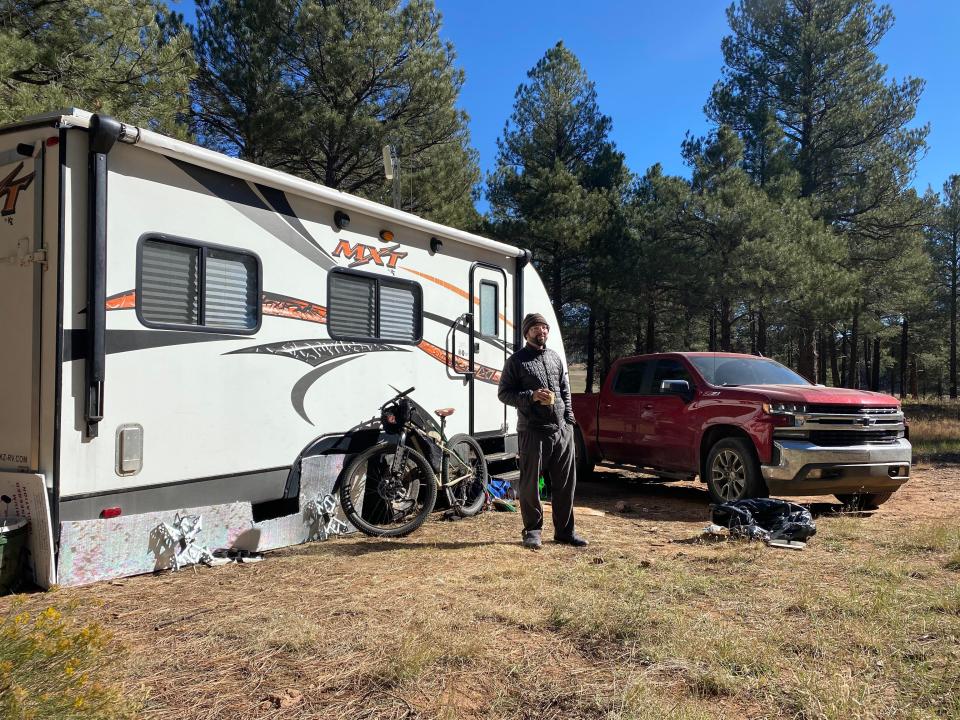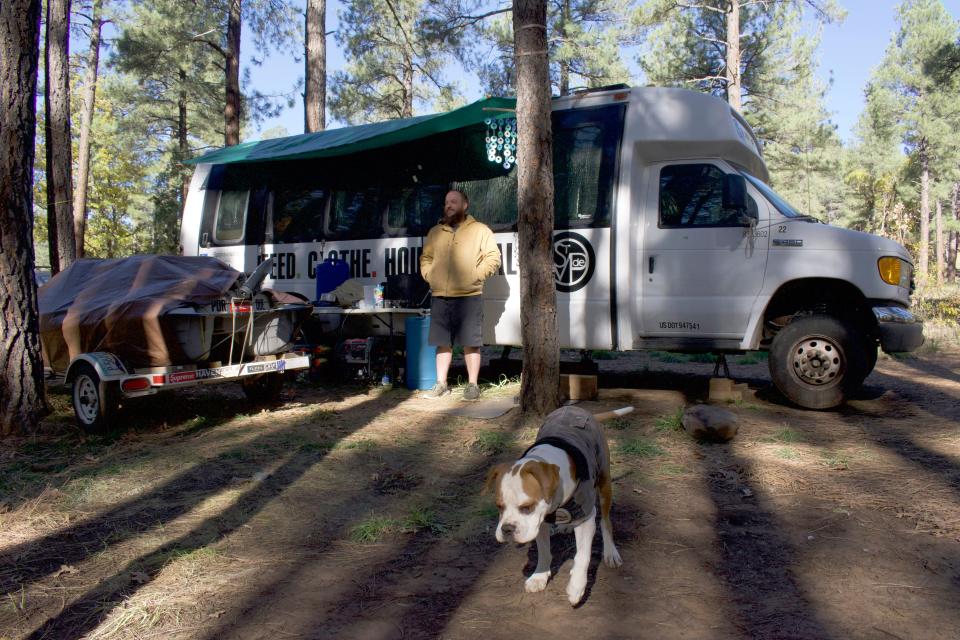Permanent campers: Rising rents are pushing people to live on public lands
For the past few months, Morgan Rice has called Coconino National Forest home.
Rice and his girlfriend — along with their dog, Rio, and their cat, Kit — have been camping full-time in their 32-foot, 2006 Ford diesel van since August. When monthly rent for their one-bedroom apartment in Avondale increased from around $800 to over $1,300, the couple simply couldn’t keep up.
“They outpriced us,” Rice said.
So they traded in their Jeep, bought the van and hit the road.
As housing in Arizona and across the nation becomes increasingly unaffordable, more people are flocking to the forest and setting up camp on public lands — for good. To some, living off the grid is a lifestyle choice. For others, it’s a last resort. Average rents in some parts of Arizona have increased by as much as 30% or 40% since 2020, pushing many people out.
The growing trend is, in part, a side effect of the state’s deepening housing crisis. It’s also raising concerns about the potential impacts on the state’s protected lands and nearby communities.
In the wake of this year’s destructive wildfire season, the influx of campers has some northern Arizona residents and forest officials on edge. While many campers are careful and respectful of the land, a stray cigarette butt or dinnertime campfire could set the forest ablaze. The Pipeline Fire, which tore through more than 25,000 acres just several miles north of Flagstaff in June, was started by a 57-year-old man who burned toilet paper and put it under a rock.
Long-term camping poses other challenges as well. Garbage needs to be collected, and the campers need to be checked on for their own safety.
But for some people who have recently started living on public lands, trading in unaffordable rents for a more cost-effective and adventurous lifestyle has been worth it.
For Rice, van life isn’t perfect. Moving every few weeks can be a pain, and he has to drive almost an hour to his job in Sedona. But his van has everything he needs, including a TV, a queen mattress, two kayaks and a spice rack. He and his girlfriend make a point of keeping it clean and even participated in a forest clean-up in the fall.
All in all, he doesn’t miss apartment life.
“We’ve got a great view of the stars," he said. "Don’t have any noisy neighbors."
Housing: Catholic Charities' PATH program helps unsheltered people living on public lands
'I'm getting old, and it's kind of crushing'

A long-term camper, also called a "nonrecreational camper" by academics and forest officials, is anyone who camps longer than the two-week limit in place on most public lands. This category includes everyone from people experiencing homelessness or trying to escape rising rents to retirees in RVs and free spirits living off the grid.
The idea isn’t new. Research shows people have taken refuge on public lands since the Great Depression. In 1992, the National Forest Service even set up an Oregon campground exclusively for people experiencing homelessness.
Because long-term campers are transient and can be difficult to find, there is no reliable data on how many of them exist. But experts agree that the trend is on the rise.
In late October, The Arizona Republic spoke to more than half a dozen campers living in the Coconino National Forest near Flagstaff.
For some, the decision to move to the forest was easy.
“Homes are terrible, and they cost too much. Might as well live in a trailer,” said Shaun Ylatupa-McWhorter, a remote tech worker. After rent for his two-bedroom apartment in central Phoenix increased to $1,800, he bought a 24-foot trailer, outfitted it with solar power and a few stand-up desks and moved to the woods in the summer of 2022. He spends his free time biking, rock climbing and composing music on modular synthesizers.
Nearby, Chelsea Henning lives with her boyfriend and their dog, Kaya, in a renovated yellow school bus nestled among evergreen trees. Henning, who cleans houses in Flagstaff, said she’s always wanted to live off-grid. When her rent there increased, she made the leap. The bus was about $10,000 after renovations, she said.
“The opportunity came up, and I just jumped on it,” said Henning, who still travels into town each day for work.
Arizona has a housing crisis. Here's how legislative candidates plan to fix it
For other people, camping is a last resort. Pamela Karr-Wiseman and Daniel Wiseman lost their jobs during the pandemic and were soon evicted. For the past two years, the couple has been living in tents off of a dirt road deep in the forest.
“I always worked,” Karr-Wiseman said. “I’ve established lives, households, lifestyles more than once in my life. And to have it happen this time, again — I’m getting old, and it's kind of crushing.”
Arizona is in the midst of an affordable housing crisis. The state is short roughly 270,000 housing units, according to the Arizona Department of Housing. Phoenix-area eviction rates climbed in 2022, following the end of pandemic-related eviction moratoriums. The Valley has also experienced high inflation, making housing even less affordable.
A 2019 study by the U.S. Forest Service and San Jose University explored the link between homelessness and long-term camping.
“Taking up temporary residence on national forests can be a low-overhead option for those experiencing poverty, job loss or housing displacement,” the study found.
Matthew McGrath, the Flagstaff District ranger for the U.S. Forest Service, said he’s seen a steady rise in the number of long-term campers over the past four years.
“Flagstaff real estate continues to be insane, and so we don’t anticipate a decrease in it, even though it is technically illegal,” he said.
Caring for the land — and people

The U.S. Forest Service’s mission is twofold: “Caring for the Land and Serving People.” But as long-term camping increases, the two things can be at odds.
Long-term camping has, in some instances, resulted in environmental disaster. In 2006, a chronically homeless man living in the woods started a forest fire in southern California by throwing one or two cigarette butts on the ground. The Day Fire burned over 160,000 acres of Los Padres National Forest and cost $73 million to fight.
Long-term camping can also result in other environmental harm, such as the creation of unauthorized forest roads and the disruption of wildlife. Research into the practice has shown that long-term campers are more vulnerable to violence, domestic abuse and drug use.
Flagstaff resident Travis Boren, who lives near Walnut Canyon, said the increase in campers of all kinds has been “incredibly scary.” A group of people illegally started a bonfire just several yards from his driveway last summer, he said. Meanwhile, the Pipeline Fire was tearing through land just a short distance away.
“I think to some degree it’s ignorance and not understanding the fire restrictions,” he said. “You would think, though, when you can obviously see a massive fire across the mountain range, people would have more common sense.”
McGrath of the U.S. Forest Service said balancing campers’ humanity with the need to keep the forest safe can be a struggle. While fires are the most pressing concern, his colleagues also clean up mountains of trash that some campers leave behind, including five-gallon buckets of human waste.
“We can fill up a pickup truck full of trash in no time, take it to the dump, and there’s still dozens of trucks' worth of trash left behind,” he said.
In 2015, a homeless man was convicted of dumping 8,500 pounds of litter in the Uncompahgre National Forest in Colorado. The trash had to be airlifted out of the forest by helicopter.
Steve Johnson, founder of the off-grid camping website Boondocker’s Bible, said it’s not fair to group all campers together. He believes it’s weekend campers and a small number of homeless people who start fires and leave trash, not people living in RVs or cars, as they have a vested interest in keeping public lands open.
“Rather than pointing the finger at increased public use of these lands, the blame should be on decreased funding for fire crews and forest rangers,” he wrote in an email.
Community outreach: Catholic Charities' PATH program helps unsheltered people living on public lands
Difficult to enforce camping rules
It is illegal to camp longer than two weeks in most areas of public lands, according to federal law. But forest officials said the rules are difficult to enforce.
Between January 2020 and November 2022, federal law enforcement issued over 300 citations in Arizona for camping longer than allowed on national forest lands, according to data from the Central Violations Bureau, an entity that processes tickets for minor offenses on federal property. More than a third were issued in Coconino National Forest.
Those numbers likely capture only a small fraction of people who overstay the two-week limit. McGrath, of the Forest Service, said the time limit is incredibly difficult to enforce. The district has only two law enforcement officers covering 1,300 square miles.
“To prove that someone is there for all 14 days, we would almost literally have to be there every day and see them,” he said.
Brian Hires, a spokesperson for the Bureau of Land Management, said issuing violation notices is a “last resort.” Rangers typically try to connect people with resources first, he wrote in an email.
McGrath said the U.S. Forest Service is working with Flagstaff and Coconino County to find long-term solutions.
“If we’re just trying to chase people out of the forest, we’ll do that forever,” he said. “But if we can find those people a better opportunity, that’s a win for everyone.”
Republic reporter Lacey Latch contributed to this report.
Juliette Rihl covers housing insecurity and homelessness for The Arizona Republic. She can be reached at jrihl@arizonarepublic.com or on Twitter @julietterihl.
Coverage of housing insecurity on azcentral.com and in The Arizona Republic is supported by a grant from the Arizona Community Foundation.
This article originally appeared on Arizona Republic: Rising rent pushing people to camp on northern Arizona's public lands

